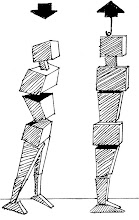
The past two years I’ve been developing a greater appreciation for what it takes to have a healthy approach to care of your body and keep it pain free. This includes three essential ingredients: alignment, flexibility, and stability.
Aligmnent
Robots are always perfectly aligned. The nature of a machine is that it must maintain perfect integrity in order to work well. The human body is similar in this regard. Though we have much more availability built into our design than a man-made robot we have a fundamental need to maintain the body’s design within certain tolerances. Most people inherently understand “bad posture” leads to pain or at least creates a poorly projected self image. There are millions of cell interactions, and hundreds of muscular actions every moment in our body – within such a fine tuned instrument it is amazing the amount of leeway we do have in what is considered good alignment or good posture. Ida Rolf called the center line – or line of gravity – the best indicator of good posture. If we can drop a plumb line from the top of the head through the body, would we be balanced along it or would certain parts be more forward or back, twisted to one side or the other? Healing arts such as chiropractic, Alexander technique, physical therapy, and Rolfing seek to educate and promote proper alignment recognizing that though we’re not robots, we do have an optimal position/posture to work from.
Flexibility
When a violent storm comes, the tree can snap but the grass will bend with the wind and thus survive unscathed. This is the quintessential picture of flexibility that there is intelligence to moving well, and not being so stuck in a pattern that it leads to destruction. Humans have a range of flexibility that has been mapped out by disciplines such as yoga and dance. Simple stretching keeps our tissues pliable, rubbery, and soft. Picture another mammal – the mighty Leapord. He has incredible power to pounce, and wrestle his kill. But also when the show is over, he has a certain a fluidity, a flexibility as he relaxes decadently in the tree or bush. The languid lounging powerful cat is a model for this kind of optimal interplay. When we are inflexible our body can actually create injury – not bending with a task can lead to undue wear and tear. Disciplines such as stretching, yoga, dance, massage, and Rolfing all deal with ways to open the tissues and enhance the lengthening and elasticity of the tissue thus counteracting a process of toughening that desk work, and aging seem to promote.
Stability
The flip side of the flexibility coin is stability. No system can be functional without stability. Even the smallest components of life – atoms – are created out of a stability of charges and energy. Similarly, our entire galaxy and cosmos are held together by forces that maintain a pattern, allowing for movement but also creating order. Our bodies are the same way. Intelligent stability in the body means that the proper muscle fibers and nerves fire and move in the correct pattern. Tightening your shoulders or clenching your jaw may seem (unconsciously) like a good way to “get it together” but this kind of stability can actually be counter-productive. The kind of stability I’m talking about is layered. Models used by disciplines such as physical therapy, Pilates, dance (Daly & bar method) recognize that the orchestration of movement starts at certain muscles/fibers and proceeds to others. This timing and proper “core stability” leads to a beautiful movement in concert. A good personal trainer, Pilates instructor, or physical therapist understands this and can guide you to create a stability and firing of muscles that will work for you in a productive way. It will promote the stability in action and the consciousness of movement that can keep you from “breaking something” in the midst of a performance.
Posted by Greg Brynelson on Oct 13, 2010




